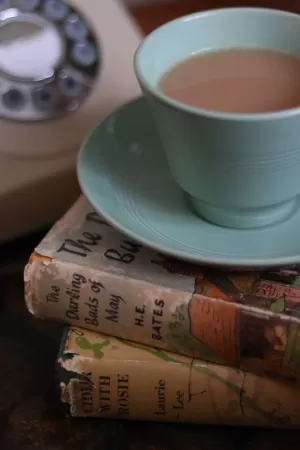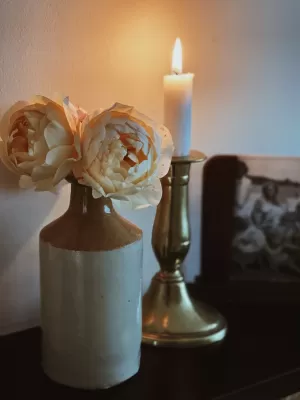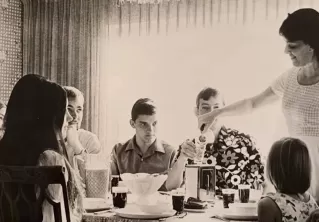How to live a simpler, more traditional lifestyle

All too often, we get swept up in conversation surrounding how a traditional housewife relates to her husband that we forget to take a moment to consider how she relates to her lifestyle, her home, and her approach to living. The remit of being a traditional housewife extends beyond her marital status into every fibre of her being, and I’d like to share with you what that looks like.
It’s also important to remember that though there are a lot of housewives who are talking about traditional living, more and more singletons, divorcees, and younger generations are asking how they can learn to live a simpler, and more traditional life. After many emails and requests to cover this, I wanted to share with you a few tips on how I adjusted my formerly “thoroughly modern” lifestyle into something that makes me happier, has slowed down the pace, and helped me step into becoming the woman I truly wish to be.
Do bear in mind however, that living “traditionally” isn’t a one-size-fits-all prescription, and you aren’t failing at it unless you shun all technology and live like a Pioneer (though you can if you want). Living ‘more’ traditionally just means you are mindful of including a little of the old-ways of living so that you won’t hurtle a thousand miles an hour toward places you might not want to go. Think of it like the brakes on your car, the accelerator takes you to your destination, but using the brakes, and shifting down-gear from time to time slows the journey and makes it safer.
In a world that is constantly encouraging us to seek more - be it possessions, status, money, or followers - it really pays to take a step back from time to time and figure out if remaining in the fast lane trying to keep up with the Joneses, your colleagues, or your friendship group is really worth it, or indeed, making you happy.
To my dear readers who are fed up with the status quo of modern life, perhaps it’s time to learn how living simply and traditionally can help and improve not only the planet, but our personal relationships, our home life, and our mental health too.
![]()
How to create a simple, traditional, and vintage inspired life.
Step One: Turn off the TV.
 I’ve always loved TV, as someone who used to act, and dreamed of being in the movies, television played a big part in my life. I was a sucker for British soap operas, American sitcoms, and cooking shows. Until one evening, having recently had our baby, I was trying to raise my voice above the background noise of the TV in order to speak to my husband - we had an epiphany moment right there that was utterly life changing.
I’ve always loved TV, as someone who used to act, and dreamed of being in the movies, television played a big part in my life. I was a sucker for British soap operas, American sitcoms, and cooking shows. Until one evening, having recently had our baby, I was trying to raise my voice above the background noise of the TV in order to speak to my husband - we had an epiphany moment right there that was utterly life changing.
We realised we had allowed a whole other family’s drama into our lives! I believe it was Coronation Street on in the background, Britain’s longest running, and much-adored soap opera - choc full of drama and tension, not to mention constant adultery, abuse, and murder.
Stepping out of the hypnotism for a few minutes, it suddenly dawned on us both that all these characters ever did was shout at each other, and we, as a couple were shouting at each other over the show in order to be heard in our own home.
What’s more, none of these characters, in all of the shows seemed happy. Not one!
Suffice to say, it has been almost eight years since we watched a soap opera. I can’t say I miss it, and the difference is astounding - no more drama, and so much time has been reclaimed to put towards positive activities and entertainment. I realise that some readers may be fans of particular shows, but the point is this…they are not always a good influence.
Traditionally minded people are careful not to allow ‘drama’, (real or scripted) enter their lives to subconsciously influence it. A good question to ask is this; by having these programmes on are your children taking social cues from these shows? Are you? Next time you watch your favourite show, truly question how it makes you feel. Many people eliminate negative and draining people from their lives, but sometimes our “entertainment” can be just as negative an influence.
Your eyes and your ears are the window to your soul. What you allow “in”, particularly in the form of media from TV shows, movies, books and music, will have an effect on how you feel about your own life. Horror movies can make you feel anxious, dramatic plots and aggressive story lines can influence how you feel about fellow man, and some books can cause dissatisfaction with your life, especially your love life (I’m looking at you Mr Grey).
We still watch TV of course, but we are very selective about what we consume and never have the TV on in the background. We also record the shows we enjoy so we can see them advert-free.
Traditionally minded people will want to spend their time watching educational, inspirational, and wholesome content. It’s ok to watch something a little “trashy” or silly here and there for light entertainment too (we happen to be fans of TOWIE), but we take it with a pinch of salt.
Step Two: Turn off the lights.
 Think of an ideal romantic date, family dinner setting, Christmas scene, or cosy-home aesthetic, and you’ll realise the lighting probably plays a big part in creating an atmosphere that feels comforting and welcoming. Electric light is fairly new in the grand scheme of homemaking and ‘home living’, but you’d be forgiven for thinking we need it on all the time.
Think of an ideal romantic date, family dinner setting, Christmas scene, or cosy-home aesthetic, and you’ll realise the lighting probably plays a big part in creating an atmosphere that feels comforting and welcoming. Electric light is fairly new in the grand scheme of homemaking and ‘home living’, but you’d be forgiven for thinking we need it on all the time.
Lighting is something many of us take for granted, or don’t even care to think about, but it plays a huge part in creating a homely atmosphere and even influencing our mental and physical health. Those who live traditionally are always seeking to create a haven away from the bright lights of the world. Low level lighting, and choosing to eliminate screen time (especially after dark), can be a huge advantage towards helping you live a slower paced lifestyle.
The blue light that is emitted from the TV, tablets and your mobile phone can interrupt the production of melatonin. This is a chemical in your brain that helps to induce relaxation and sleep when the natural light levels (at sunset) go down. Not allowing the body and mind to adjust to “night time rhythms”, by stopping the flow of this hormone, can cause restless sleep patterns, and even insomnia. It’s one of the simplest switches (excuse the pun) you can make to slow the pace of your day, and make yourself feel more rested. Come sundown, refuse to use overhead lighting - instead opting for low level lamps with warm white bulbs, candlelight, and ideally no handheld screens. Perfect hygge.
If you do watch TV, make sure to do so in a room with a warm light source that can counteract the blue light (such as a few candles, or a small lamp in the corner of the room).
This may at first seem like an odd step to take, but you’ll soon notice the benefits in home atmosphere, sleep patterns and the pace of life in your home once the sun goes down. Surprisingly, people are much likelier to talk in soothing, hushed tones if the light is low - perfect for harmony in the home! Do not try to extend the day with lots of electric light. Night and day were created for a reason. Embrace both blessings, and these natural rhythms of life, as naturally as possible.
Step Three: Reject new, where you can.
 Perhaps it’s part necessity, because of the need to be frugal, but a lot of people who choose to live traditionally like to ‘buy traditionally’ too - and that almost always means secondhand, nearly new, and local.
Perhaps it’s part necessity, because of the need to be frugal, but a lot of people who choose to live traditionally like to ‘buy traditionally’ too - and that almost always means secondhand, nearly new, and local.
The lifestyle dovetails perfectly with saving money, and also highlights the appreciation for goods that are well made and stand the test of time. With the state of manufacturing oversupply and competition today, in order to buy “quality” it may often require buying secondhand. Home goods, clothing and even technology can all be bought for incredibly reasonable prices which is not only nicer for the budget, but better for the environment too.
It also may appear a little patriotic, or imperialist, but do consider buying British, or American etc where possible. The jobs and industry in your home country relies upon your custom - else everything, in time, will be imported from countries where standards of manufacture are poor, and will continue to support unfair wage and employment practices. Reject “fast” consumer products such as fast fashion, cheap plastic products and imported goods that seem like a “bargain”. Buy once, buy well, buy to last.
Traditionally minded people care a great deal about their environment, and how their consumption habits can make an impact on it - and therefore they choose to:
- Search antiques shops, charity shops and online secondhand market places for home goods.
- Buy local where possible, especially food and fresh produce.
- Shop small, and purchase from artisan makers - lining their pockets directly instead of the middle-man’s.
- See the joy in the patina and “stories” of items - thus releasing them from the pressure of having to buy perfect/new.
- Realise that their possessions do not define them, and therefore reject trends.
Step Four: Get a hobby that gives back.
Chances are as an adult, the world seems to want to leave you little time for hobbies. Long working hours, and the demands of life often sends you to the sofa exhausted from the pace of it all. Instead of watching those shows we mentioned, why not use these hours to learn how to knit, grow your own produce, woodwork, or preserve food. Hobbies like these are mindful, gentle, and life-giving.
One of my favourite verses from Scripture lays it out plainly, but beautifully:
Make it your goal to live a quiet life, minding your own business and working with your hands. 1 Thessalonians 4:11
I believe that we are never too old to learn a new skill, or take up a new hobby - but rather than rely on technology, or expensive classes and equipment to entertain you - turn your hands to old skills, as these are the ones that most often give back. They produce goods you can use, gift, or sell. They provide you with useful skills that come in handy when you least expect it (vegetable gardening during a global pandemic springs to mind), and not only does it give you something productive to do, but something quiet and mindful.
Hands that are kept active, soon soothe the mind and the soul. It can often nourish the body too, and line the pantry shelves. Hobbies that preserve the harvest are the best kind, as they insure you for the future. Remember what it felt like six months ago when there was panic at the supermarkets, and short supply of the essentials?
Traditional homemakers learn to live with less, so they can have more. Effort is put into stocking the house with the things that families truly need to get by, not materialistic items.
If you have a warm place to sleep, and a full belly - you have everything.
Make it your goal to live a quiet, simple life, minding the business of your home(making), and work with your hands to see that the job is done well.
Step Five: Learn to love what you have, and who you are.
Social media, and all the attention we give it has the ability to destroy our self-esteem and contentment. There is a reason that the Silicon Valley App developers refuse to let their children use these platforms - it’s because they know they are programming them to create an addiction, and reliance. Those dopamine hits we get when someone hits “like” are programming us to use those indicators as a way of measuring our own self-worth and self-esteem. It is not healthy, and incredibly concerning.
Sadly, I know that for many of us, the use of these platforms can be a necessary evil - especially when we have a message, business, or product to share. However, as much as it’s a wonderful tool for sharing ideas and connecting with likeminded people, there is not much within those little screens that is truly life-giving, or makes us like ourselves very much.
I can plainly see other #TradWives who have nicer homes than I, and are far prettier. I can be made to feel incredibly inefficient, or not as good at baking, sewing, or gardening etc. I have even witnessed some people use the same network, hashtags and platform for their own gain and self-promotion rather than seeking to help the movement. I can see right through it and it’s upsetting… but I realise I have a tool under my belt that helps me in these moments. I have to remind myself often that life is not a competition and ask “what would someone living traditionally” do?
What would a traditional homemaker from days gone by do? What would a traditional author of days gone by do too? What would Enid Blyton, or Jane Austen, or Louisa May Alcott have done when faced with this dilemma or feeling? Well, they wouldn’t turn to their phone - social media didn’t exist and they were still successful…
Don’t give the modern stuff, and the opinions of strangers so much credence. The narrow path is called the narrow path for a reason - it’s not actually called “the narrow racetrack”. You are on your own journey, with your own special set of skills and life experiences…remember that.
This last step is probably the most crucial, if you’ve read Ladies Like Us, you’ll know my feelings about the value of life experiences (both good and bad), and the impact daily choices can have on your lifestyle.
You are wonderful just as you are, especially with your flaws. It’s not your past that defines you, but where your heart is now. Don’t allow other people to keep you down, only you have the power to shape your day, and your tomorrow.
Learn to love the simple things, like reading a book to your child. Or taking a walk in nature. Disconnect from the world that always wants your attention - and most of the time, only to sell you something!
Yesterday existed in a world that was simpler, and tomorrow can too. All we need to do is make traditional choices that soothe our soul, rather than feeling like we have to follow the pattern of the world. What will you do to make that so?
![]()
Living “traditionally” can sometimes make you feel a little out of place in this modern world, especially when other people may remark on your lack of passion for the latest Kardashian gossip. Or comment on the fact that you’ve been carrying the same handbag year round. They may also make jibes about the beat up (but reliable) old Volvo you drive while hiding the fact they are maxed out on their credit card from the upkeep or payments on their newest model vehicle. “Fitting in” isn’t always what it’s cracked up to be.
What is traditional living?
In a nutshell, traditional living is taking a moment to stop and take stock of your choices. It’s about slowing down the pace of life and considering the circumstances and consequences of even the tiniest of decisions. Traditional choices are generally the ones that give rather than take, and have a positive impact on all those involved.
“Traditional Living” is now a counterculture in itself. Modern living often seeks the self, whereas traditional living seeks community and contentment through the simple things in life.
I know which I’d rather!
Happy Homemaking,
Alena xxx
If you found this post useful, would you kindly consider supporting the blog and buying the author a one-off cup of tea?
All content and images in this article are copyright of The Darling Academy and are not to be shared or reproduced without our express permission. With thanks to my dear friend Mrs. Sian Warr for providing images to use in this blog post. http://www.instagram.com/this.nostalgic.life Affiliate links have been used.


